The Putto - Angels in Art
by Lin Vertefeuille, 2005
Introduction
Putti proliferate in popular culture: on buildings, in decorative arts, on greeting cards
- a popular purveyor of love. But in Art through the ages, the putto has been a curious
little figure, often reflecting philosophy, theology and literature of the time. The putto
in Renaissance art was a winged or wingless, male child figure. The word putto
(plural putti) in Italian vernacular was derived from Latin putus,
meaning "boy." Putti were secular, sometimes profane and definitely not part of
the nine choirs of angels. However, in the Baroque period of art, the putto was often used
in a religious context and the distinction between being secular and ecclesiastic became
less defined.
Beginning of the Putto- Greek, Roman
The conception of the putto reaches back in art to the ancient classical world, where
winged infants were physical manifestations of invisible essences or spirits called genius,
genii, that were believed to influence human lives. Love putti (erote)
were familiars of Eros and Venus. In Bacchanals, which were celebrations of Dionysius
(Bacchus), putti represented fertility, abundance, the spirit of the fruit of life and
were often depicted in wild revelry. Most intriguing was the ancient creation of the larvate-putto
(to be explained later.)
Winged infants were found flying across Etruscan pottery holding garlands of fruit. In the
Roman era carved stone garland swags of leaves, fruit, and flowers [Latin: festa
corona] supported by young male children were important ornamentation and festoons on
buildings and sarcophagi.

Creation of the Putto- Renaissance
During the Middle Ages putti disappeared .... and then reappeared in early Renaissance
Italy. During the Quattrocento, Italians had great interest in their Roman heritage and it
became popular to use two kinds of architectural ornamentation called reggifestone
and reggistemma to adorn churches, funerary objects and public buildings. Reggifestone
was reminiscent of the Roman style of garlands held by putti. One of the earliest
Renaissance examples of this form was the Tomb of Ilaria (1406) by Jacopo della Quercia.
It was described as celebrating Ilaria's beauty and life, not her death, and was decorated
in garlands held by "ingenuous children"
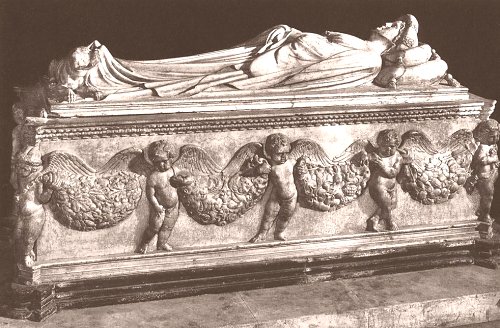
In the reggistemma architectual style of ornamentation, there were usually two
flying putti flaming and flanking either a shield, coat of arms or scroll with text. An
example of reggistemma is on the upper walls of Ringling Galleries 1 and 2.
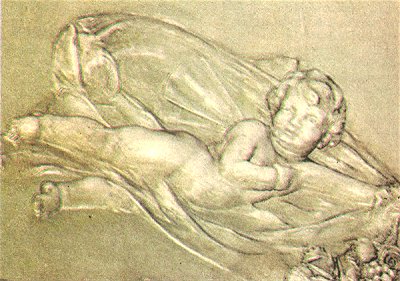
Donatello has been called the real inventor of the putto. This is because he
gave the putto dynamic personality, character and spirited animation. Most significantly,
he integrated the putto into the context of his sculpture and made the delightful little
figure a participant in his work of art. In this way he expanded the putto beyond mere
ornamentation and static embellishment. In Donatello's Cavalcanti Annunciation in
Santa Croce, Florence, the Virgin is shown mastering her fear after being first startled
and then recoiling from Gabriel's announcement.
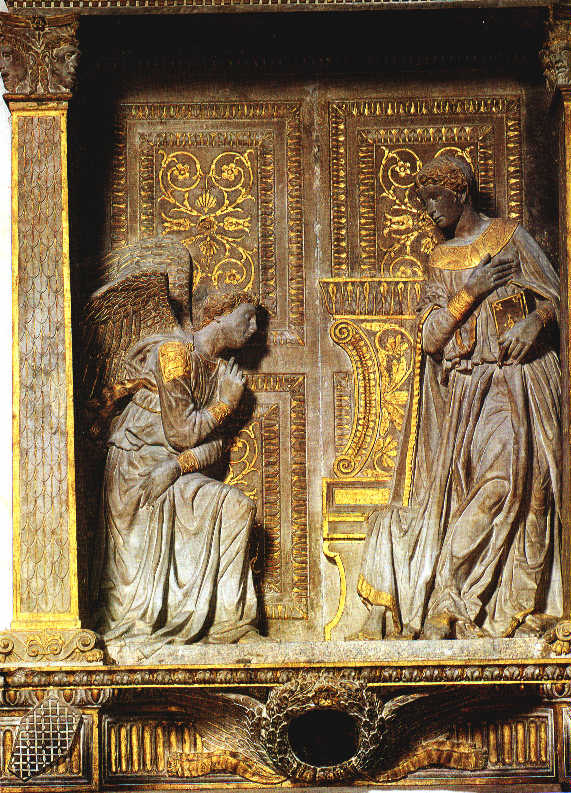
Her surprise and sudden rush of fright the moment before, is reflected in the behavior
of the putti on the frame above her. They mischievously push each other to the shelfs edge
and in childish fright, a putto crouches behind the another peering out hesitantly.
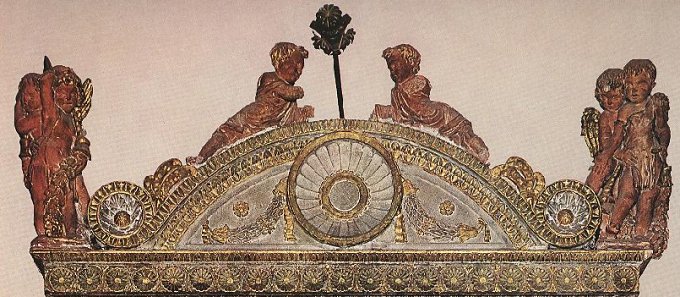
In written contracts of his works, Donatello, referred to his delightful chubby putti as
"spiritelli." This term was particularly descriptive because it was the
diminutive of "spirito - spiritus" which translated from the Greek
"pneuma" meant a spirit, a movement of air and even the act of breathing. Spirit
was the breath of life animating the human organism and departing from it at death. It was
believed that invisible spirits drawn from air were mixed with blood in veins and
arteries. Blood transmitted sustenance and sensations that entered involuntarily through
sensory organs. There were three main types of spiriti: (1 .) natural spirits in the liver
expanded through the body providing nutrition of life - supported by essences in water,
meat and fruits of the earth (2.) vital spirits resided in the heart attended by pulse and
respiration (3.) animal spirits were the most rarefied and located in the brain, rushing
through nerves connected to sense organs where they receive external influences
communicated by spiriti sensitivi. The spiriti sensitivi were many, varied, and caused
random impulses, and emotions such as: surprise, sudden erotic arousal, panicky
disturbances, drunken giddiness, wonderment, joy... This is where we get that
expression," as the spirit moves." The putto-spiritello was the physical
representation in art of these invisible spirits that evoke emotion and thought in all of
us.
Love - Putto
In scenes with Venus, Eros (Cupid) and nymphs erote-putti were spirits of love. Sometimes
they represented gentle subtleties such as catching someone's eye, or why we are attracted
to a certain someone and other times they represented strong passion. A less familiar
aspect to us is the erote ceremonial procession popular in the Renaissance Florence.
Lorenzo de' Medici celebrated love in a Triumph of Love procession. A triumphal car
(trionfo) decorated in gold, silver and jewels had Eros featured in the center with erote
on each comer holding flaming torches. Young men and women as lovers walked beside the
trionfo surrounded by music and merrymaking. This kind of procession related to feudal
rituals rooted in chivalry and courtly love. Sometimes these processions were more subdued
and celebrated the triumph of chastity.
In Counter-reformation art, erote were allegorical representations of God's love, our love
of God and the Church. In the 18th and 19th centuries romantic images of love were popular
and the endearing erote became quite sentimentalized. Today the putto is often referred to
as a cherub. This is not to be confused with the Cherubim~ which are one of the Choirs of
Angels. The putto is neither angel or Cupid. However, they were frequently combined with
angels or used in the context of angels in art of the Baroque period.
Bacchanal - Putto
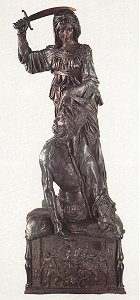 |
|
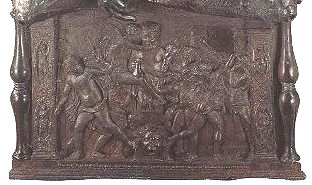 Another
popular application of the putto was in the bacchanal. In Donatello's Judith and
Holofernes (left), putti cavort and act out the effects of inebriation- loss of
judgment and narcotic sleep that overwhelmed General Holofernes and brought him to his
shameful end (closeup above). |
|
Putti celebrating revelry in honor of Dionysus reinforced
the dangers of such excesses. Larvate putti and satyrisci (small satyrs) were the spirit
of wild abandon (orgy) and (larval) hallucinations. Bacchanal scenes celebrated
fertility and abundance and hard working putti tended the vine representing the natural
spiriti that give us sustenance. Today we still refer to alcohol as "spirits." |
In Christian art the bacchanal had quite a different meaning. Wine became the symbol of
God's blood and sacrifice. In a parable Christ said,"I am the Vine" and early
church fathers referred to "the grape trampled for our salvation. The putto was the
natural spirit (pneuma) animating from the vine as a nourishing substance. Putti tending
the vine were nurturing our faith. Sometimes bacchanals depicted infant putti attacking or
riding a goat. This theme came from Virgil's reference to new shoots and leaves as
"the tender child" who must be protected from the sharp-toothed goat.
The Bacchanal painting by Luca Giordano in Gallery 8 is a wonderful example of
Bacchanal putti. Visitors often misinterpret the wine for blood in this orgy. This is
certainly not a representation of Christ's blood.
Larvate - Putto
The larvate was an enigmatic spiritello. This putto was shown in mischievous antics
playing bogeyman, scaring companions by wearing the Silenus mask and often playing with
Mars's helmet or shield. The putto behind the mask was called a larvate
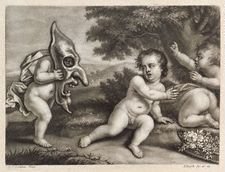
|
|
The mask was the ugly face of Silenus, who was the hairy debauched satyr companion of
Bacchus. The larvate represented empty fright - those frights we feel that are unfounded
and without real cause. They are involuntary conflicts and desires that prey on the human
heart. Ralph Waldo Emerson referred to these frights as "hobgoblins of little
minds." They could be serious as our fear of death or lesser childish ones- the point
was they were frights that haunt us but we can do nothing about them. Also our' fears may
be greater than the reality of what we fear. A great description of the larvate is,
"The mask pretends to cover something tremendous and terrifying, but which is really
nothing" - just a little putto playing pranks. When the larvate was used in love,
bacchanal or dream scenes, he created tension, possibly anxiety and sexual arousal.
Interestingly, the word larvate is used today as a medical term for a disease that is
masked. |
Dream - Putto
When putti were shown playing in the background or around a recumbent figure, it indicated
a dream sequence. Putti were the feelings and emotions the reclining figure was
experiencing in the dream. A dream was illustrated in the painting, Mars and Venus
by Piero di Cosimo (below) and it is so different from The Building of a Palace
in Gallery 4. It is Mars' dream and erote playing in the background with his discarded
armor show he has let down his guard. This suggests that Venus has completely seduced him
and love conquers war. This painting was owned by Giorgio Vasari, the Renaissance painter
and author of Lives of the Most Excellent Italian Architects, Painters and Sculptors.
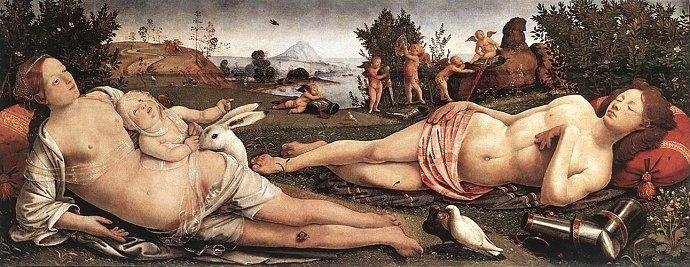
Panisci - Putto
Putti called panisci were associates of the woodland god, Pan. In mythology, Pan with goat
hoofed feet and pan flute was believed to blow a conch shell horn that evoked extreme
panic enough to terrorize the Gods and overwhelm armies. In fact the word panic is derived
from Pan. Putti in art were shown in mischievous play blowing a conch shell. These"
little pans" when they blew a conch shell, they created little panics, that were
sudden panicky distractions that confuse the mind diverting it from serious business.
Mars and Venus (below), by Sandro Botticelli, is an musing example of panisci
used in Mars' dream. You can certainly tell the pattisci are up to no good by their
malevolent facial expressions. A pancisci blowing the conch shell is causing Mars' sexual
panic-arousal The other panisci are holding Mars' lance, his phallic symbol The swirled
shape of the conch shell symbolizes woman-Venus. The panisci are thrusting Mars' lance
into Venus' conch shell. This is putti portrayed erotica!
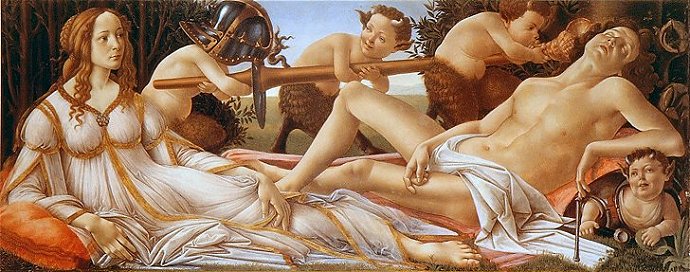
Water Sprites - Putto
Charming putto are often found in fountains holding a dolphin. These water sprites
represented the natural spirit or essence of the water and its life giving force.
Musical - Putto
To end on a high note, delightful musical putti are particularly charming as they dance,
play instruments and sing. The musical putto was the spirit of music whose rhythms and
melodies, when heard quickened the heartbeat and stirred the soul. They were exuberance
expressed by the sounds and joy felt by the listener. Donatello's frieze in the Cantoria
(Singing Gallery) in the Florence Cathedral was described in the Dictionary of Art,
"...conveys the ecstatic dance of souls of the innocent in Paradise."
Conclusion
In conclusion, the putto in the 1400's - 1600's was a personification of human spirit and
emotion expressed in art and was much more than just an endearing sentimental symbol of
love.
The Ringling Collection does not have a diverse representation of putti. Love-putti are
predominant in our paintings. They are in religious allegories and in mythological
contexts.
Putti are decorative architectural elements found in the Museum's door surrounds and are
quite prominent on the fireplace and on the wall cornice Gallery 21 (see photo below).
Reggistemma (a shield flanked by two putti) is displayed just below the clerestory in
Galleries 1 and 2.
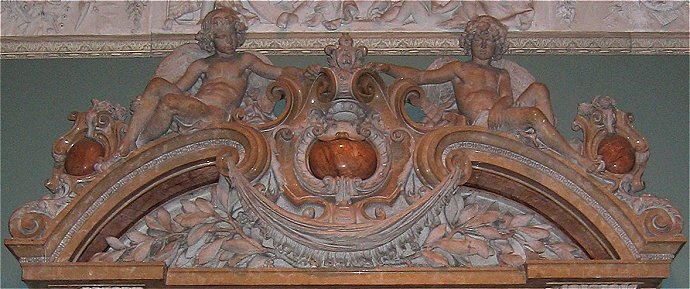
Peter Paul Rubens effectively used reggifestone in three of our Eucharist paintings: The
Four Evangelists, The Meeting of Abraham and Melchizedek and The
Defenders of the Eucharist. Putti with garlands of fruit are in the act of
decoratively hanging the tapestries, cleverly creating the illusion of a tapestry within a
tapestry.
Sources:
Dempsey, Charles. Inventing the Renaissance Putto. University of North Carolina
Press, Chapel Hill and London, 2001
Duston, Allen and Nesselrath, Arnold. Angels frorn the Vatican. Art Services
International, Alexandria Virginia, distributed by Harry Abrams, Inc.,44 - 60. 1998
Hall, James. Dictionary of Subjects & Symbols in Art. Westview Press,
Boulder, Colorado, 1979
Dictionary of Art, Macmillan Publishers Limited, London 1996
ringlingdocents.org
|










